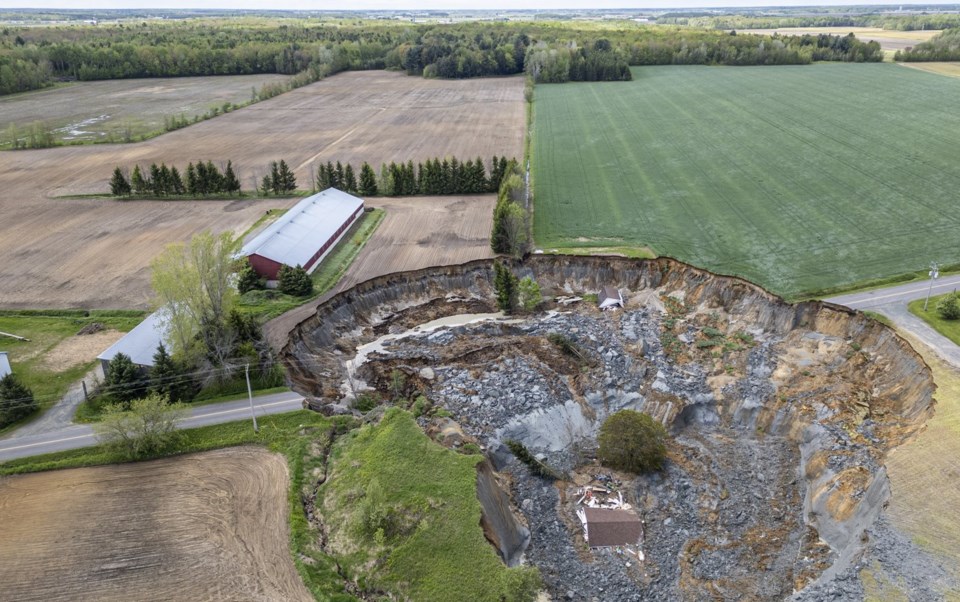SAINTE-MONIQUE — André Lemire said he was woken up early Wednesday morning by his partner, who had heard ominous noises outside the farm where they live in Ste-Monique, Que.
They left the home, and when he looked back he saw the ground open up, swallowing up the land and his neighbour's house.
"The path disappeared behind me," Lemire said in an interview.
A major landslide swept away a home and part of a road northeast of Montreal at around 6 a.m. Wednesday, leaving a gaping hole in the land but no injuries. The landslide – estimated at 760 metres long and 150 wide – was described by an expert as one of the biggest the province has seen in recent years.
Lemire, who has lived in the area for decades, said the region is known to be landslide-prone. "I knew what was happening, because I knew it would happen one day," said Lemire, whose farm is by the Nicolet River.
Lemire said his neighbour, Fernand Therrien, was able to escape before the landslide consumed the home. Another neighbour said Therrien owned four dogs, who were also safe.
Sylvain Gallant, regional civil security director, told reporters in Ste-Monique that the house was empty when the landslide occurred and nobody was hurt.
On Wednesday afternoon, the roof of the buried house was visible at the bottom of the hole. Gallant originally estimated the size at 300 metres by 100 metres earlier in the day, but later revised that upward. In the morning, he said the hole was still growing.
"It's certain that under current conditions, this landslide will grow even larger because the walls are still too steep," he said.
Several surrounding homes, including Lemire's, were evacuated out of caution. Gallant said it wasn't clear when the evacuees would be able to return.
Gallant it was still too early to determine the cause of the natural disaster, but noted that there had been heavy rain in recent days. "The Ste-Monique area is known for landslides," he said. "This magnitude is quite rare, but it's an area that's on sensitive clay, so these are things that can happen."
Lemire confirmed there have always been rockfalls and slides in the region. At one time, landowners sunk wood, rocks and even old cars along the riverbanks in the hopes of stabilizing them, he said.
Ste-Monique Mayor Denise Gendron said the community of about 500 people faces landslide risks on both sides of the Nicolet River. The province has published maps indicating areas of higher risk, but she said the homes in the community predate the maps.
"Even here in the village, there is a large part that is at risk," she said at city hall, where she met evacuees.
Philippe Gachon, a professor at Université du Québec à Montreal's geography department, said a landslide of that magnitude "has rarely been seen in recent years in Quebec."
However, he said many parts of the province, especially along floodplains, are on clay, which can present a landslide risk. The land has also become less stable in recent years due to more extreme weather conditions, he said.
Clay can become unstable due to excessive rain or extreme dryness, he explained — and Quebec has seen both in recent years.
"Clay doesn't like when there's too much water, and it doesn't like it either when there isn't enough water because it has a tendency to fracture," he said in a phone interview.
Gachon, who also directs a research network that studies flooding in the province, said researchers are working to develop better tools to measure and monitor the water levels in the ground.
As extreme weather becomes more common, he says it's vital to better understand the entirety of the water cycle in the province, which he said is vulnerable to hydrological "whiplash" due to alternating periods of extreme wet and dryness.
"It's clear that with climate change, we're going to face events we've never experienced before, certain phenomena we've never seen before in history," he said.
With time, he said the province can get better at predicting landslides, and developing better tools to prevent them. "Faced with the unknown, we're going to have to develop new ways of doing things," he said.
A major landslide occurred in 1955 in the nearby city of Nicolet, killing three people and causing millions of dollars in damage.
A summary of a 1964 report on the National Research Council website said slope stability was a problem in the valleys of the St. Lawrence and Ottawa rivers due to "extra-sensitive" marine clay, which "liquefies when it is disturbed from its natural state."
This report by The Canadian Press was first published May 21, 2025.
— With files from Morgan Lowrie in Montreal
Stéphane Blais, The Canadian Press



